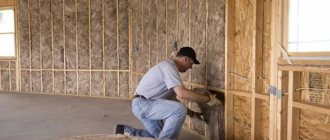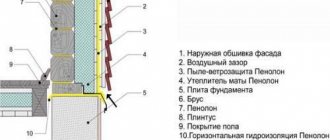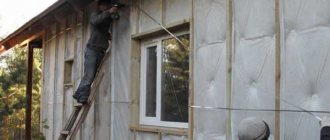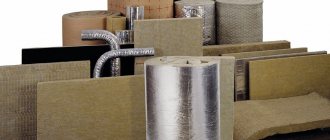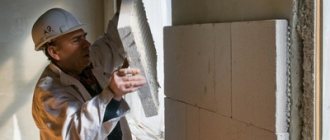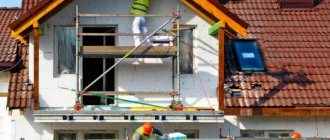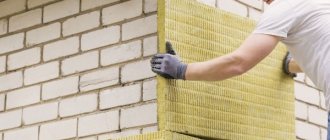Advantages of internal insulation
Insulation of house walls from the inside of the building is most in demand by those who live in multi-apartment, multi-storey buildings. In this case, it is not always convenient to treat walls from the outside.
This requires special equipment and highly specialized workers. In addition, it is necessary to obtain all permits and approvals.
The option will be the only correct one in the following cases:
- The room is adjacent to technical, cold rooms (storage room, staircase);
- It is impossible to insulate the facade from the outside;
- The building is insulated on the street side, but this is not enough.
You can treat the walls from the inside in any type of house. These are not only urban high-rise buildings, but also private wooden buildings.
A huge advantage of insulating from the inside is the ability to do the work yourself or with the help of inexpensive outside labor.
How foam blocks and thermal insulation panels are used for insulation
Foam blocks are produced in the form of facing slabs, which are laid according to the principle of brickwork to prevent the appearance of cold bridges. The foam block is glued directly to the load-bearing wall, and the adhesive mixture acts as an additional waterproofing layer.
For better grip, umbrella dowels are additionally used. Foam and gas blocks are lightweight, which makes them easier to install. Due to the fact that the concrete mixture foams during production, the material can freeze and lose strength. Therefore, it is best used with a moisture-resistant finish. It is not recommended to use foam blocks to insulate facades under plaster.
Decorative panels are a set consisting of insulation and a decorative layer. The basis of the panels is polystyrene foam (penoplex), and the decorative layer is plaster or brickwork. Installed using a special adhesive solution. The main advantage is speed and ease of installation.
In this case, there is no need to additionally insulate the facade with plaster, because the decorative layer is applied in advance at the factory. The panels look attractive and retain heat well. The only downside is that the sheets peel off from the surface, especially if you use the wrong glue. If you use dowel umbrellas for better adhesion, the appearance of the facade will deteriorate. The cost of the panels is about 3,000 rubles/m² excluding installation.
Decorative panels consist of insulation and a decorative layer
Disadvantages of insulating a house inside
Despite the significant advantages, insulating walls from the inside has some difficulties. As a result of the possibility of negative aspects, they even refuse the method, and also become opponents of this option for solving the problem.
Among the disadvantages of internal insulation technology are the following:
- Increasing the susceptibility of the outer part of the walls. Internal insulation prevents the penetration of heat to the load-bearing part of the structure. An aggressive external environment has a more negative impact on the building. The house may begin to deteriorate faster, and there is a risk of cracks.
- The appearance of condensation. At the junction of cold and warm air, droplets of moisture appear. This place becomes the boundary between the wall and the insulation. Accumulation of condensation can cause mold and mildew. At the same time, the process is hidden from the eyes of the owners.
- Reducing usable area. When insulation is carried out from the inside, the space is reduced due to the materials used. Despite the choice of modern building materials, a reduction in area is inevitable, which is especially noticeable when covering the entire perimeter of a room.
Before starting work, the potential benefits and harms of the intervention must be carefully assessed. It is advisable to obtain maximum benefits with minimal negative impacts.
Modern thermal insulation technologies
Conventional timber frames struggle to meet the latest thermal standards used in modern residential buildings. Fortunately, the latest insulation technology offers several solutions. Owners of frame buildings can choose one of the panel options or use a technique called the “inside-out method.”
Such panels are divided into 3 types:
- Custom built;
- Factory made, filled with polyurethane foam inside;
- Built-in panels for frame construction.
Panel construction has a number of advantages. These include efficient installation, thermal protection quality with multiple thermal bridges.
The inside-out method also has a number of advantages; it is worth considering, if only because this type of home insulation will cost much less. This does not require heavy equipment; all work can be carried out only with the participation of electricians, plumbers, and carpenters.
Materials used for insulation from the inside
You need to carefully select materials for insulating walls inside the house. The work can be performed using different raw materials. Each option has its pros and cons. Only knowing their nuances can you make the right decision.
Styrofoam
It is popular to use polystyrene foam to insulate walls inside the house. It has a low cost, which is important for many. In this case, the option is considered effective and easy to work with.
- Polystyrene foam is most often used to insulate indoor walls in urban high-rise buildings.
- Using the material does not require special skills or additional tools. Installation is done quickly.
- The disadvantage of the material is its low strength and flammability.
Polystyrene foam has low vapor permeability. This means that without additional ventilation equipment, the apartment will simply turn into a greenhouse, and problems with shifting the “dew point” may also arise.
Penoplex
No fewer people want to use a more durable analogue of polystyrene foam to insulate walls from the inside. Penoplex has similar characteristics.
The only advantage of this option over foam plastic is that it will last longer and will not be subject to the slightest mechanical damage. It is advisable to use penoplex in concrete and brick houses with additional forced ventilation equipment.
Mineral wool
Insulation with mineral wool is considered common. It is suitable for houses made of any materials. Hard options are especially popular. They are easy to install, durable, and non-flammable. Mineral wool is produced in rolls.
It has excellent performance characteristics:
- Thermal conductivity;
- Soundproofing;
- Vapor permeability;
- Mechanical strength;
- Resistance to biological effects.
Mineral wool will serve without complaints for at least 50 years. The advantages of this option are also considered low density and light weight. When using mineral wool, additional waterproofing is required.
This is necessary for the material to retain its properties. It gets wet quickly and loses effectiveness under unfavorable conditions.
Fiberboard for insulation
To insulate walls from the inside, you can use fiberboard slabs. This option is attractive in many respects for use in repair work. Wood boards are easy to work with and are convenient for laying communications.
Fiberboard usually does not cause problems during operation. The only disadvantage of this option is the use of chemicals for treatment before use.
Rules for selecting fasteners
Fasteners are selected depending on:
- Type of wall material from which the base is made (different anchorage lengths);
- Type of thermal insulation (in systems made of polystyrene, connectors with a plastic or steel stud are used, in systems with mineral wool only with a steel stud);
- The thickness of all insulation layers (surface layer, thermal insulation material, adhesive).
Fasteners for thermal insulation boards can be divided depending on the type of material. For polystyrene, plastic connectors made entirely of plastic are sufficient.
Plastic fasteners are required for mineral wool slabs, but with a steel stud. Both types of fasteners are available in two versions - screw-in or hammer-in.
Fastening is carried out at least 24 hours after the completion of fastening of the insulating boards. First, the necessary wiring and location of individual connectors are drawn on the wall. Then holes are drilled in the marked places with a depth slightly greater than the length of the connector.
After blowing compressed air through the holes, fasteners are placed in them and then hammered or screwed in. When the fastening is correctly installed, the surface of the slab should be flush with the thermal insulation layer.
Features of insulating walls made of different materials
Walls may need insulation not only in panel houses. No less often, this process is in demand by residents of brick and wooden houses.
It all depends on the specific circumstances.
- The insulation procedure in each case has its own characteristics.
- In any case, the walls must first be prepared.
- If in panel and brick houses this is plastering the surface, then in wooden structures the work begins with lathing.
- The second stage will always be the creation of waterproofing. Lastly, decorative finishing work is performed.
- It is no more difficult to insulate walls from the inside than from the outside of the building.
- It’s easier to do the work if you become familiar with the nuances of the process in advance and choose the right technology.
To avoid any shortcomings during operation, you must carefully study the information and follow all instructions.
"Everything is relative"
Since you and I happened to be born in the northern hemisphere, that means we have to talk about insulation. And we would like residents of the south to discuss issues about air conditioning systems. In fact, in most CIS countries, insulation is not a matter of desire, but only a matter of degree. It is clear that the inhabitants of sunny Crimea need this less than, for example, the inhabitants of harsh Arkhangelsk. And yet, the question of whether to insulate or not is not worth it. How to insulate the facade of a house, why exactly the facade, what approaches to thermal insulation of building facades are used for different types of structures? In this summary article we will discuss different, key aspects of this construction issue. The step-by-step instructions presented in this article will greatly help you when insulating the facade with your own hands.
Insulation for Russia and many other countries is not a matter of desire, but only a matter of degree
Why, in principle, do buildings need insulation? This is related to the concept of thermal conductivity. Any material has the ability to conduct or transfer heat to an object adjacent to it. And as you probably guessed, different materials or substances have these properties to varying degrees. And you, most likely, also guessed that concrete, brick and other materials for walls are those substances that conduct heat very well. This means that the energy generated by the heating system of your home is well “conducted” by the walls and freely flows into space :). The photo below shows which structural elements of the house allow heat to pass through and in what quantities.
It is not possible to completely avoid heat loss, but this is not necessary. In this case, the house would turn into a thermos. When we open the thermos, we see a large amount of steam. This is what our house would look like if the walls didn’t have the ability to remove excess heat. But a good balance between ventilation and heating is a worthwhile goal for every owner. As you noticed from the illustration, the outer wall is an element of the building that needs special insulation. There are many options for facade insulation. Let's first look at the materials and methods of insulation.
Photo of house insulation inside
Price
We tried to show the average prices for insulating the facades of houses. We will focus on the price of one square meter of insulated facade of a private house or apartment building.
Installation work on mineral wool and polystyrene foam costs approximately 350-400 rubles per square meter. The cost of the material itself, for example, let’s take penoplex 35, (Density 35 kg per cubic meter), starts from 250 rubles/m2. PSB-S foam will cost 150-190 rubles for the same unit of measurement. So, 1 square of insulated surface will cost from 500 rubles if you use the services of hired workers.
Mineral wool slabs cost from 170 to 440 rubles per square meter. This depends on the rigidity of the slab and its thickness. For a minimal price you can buy a semi-rigid slab with a thickness of up to 100 mm and a density of up to 75 kg per cubic meter.
The work of applying ecowool costs about 400 rubles per square meter. We are talking about a layer 50-70 mm thick. If you already have facade cladding installed, blowing in ecowool will cost about 250 rubles per square. We hope these figures will be very useful to you when drawing up an insulation project.
A little later we will prepare a calculator for calculating the insulation of facades in different ways. However, it is worth remembering that if you still manage to do the facade insulation well with your own hands, it is better to overpay for the work of professionals. In the end, your wasted time, effort, emotions and lack of guarantees due to lack of experience also have a “price”.
As we have seen, there are different ways to insulate facades and each of them has its own characteristics and subtleties.
If the thermal insulation of the facade causes you additional difficulties or your question was not addressed in the article, please do not hesitate to ask questions in the comments. Alexey, Oleg and other site experts will be happy to share their experience. And remember, finishing the facade and insulating it, done correctly, will ultimately save your family money.
And before leaving, one more video about insulation:
Preparing the surface of external walls for treatment with insulation
As soon as you decide how to insulate the walls of the house from the outside, you need to start preparing the surface of the walls for treatment with a heat-insulating composition.
First of all, a layer of old plaster or other finishing material from the external walls is removed. If there are irregularities and depressions on the surface, they must be smoothed out using mortar, and all bulges must be trimmed flush with the wall. Arrangement of a non-ventilated facade of three layers using foam boards.
Next, the wall should be thoroughly cleaned of dust and debris resulting from removing the plaster. Then prime with a deep penetration solution.
The further finishing of the wall or the installation of cladding depends on how even the insulation layer is.
For this, plumb lines and beacons are used. Anchors are attached to the upper edge of the wall surface, threads with plumb lines are suspended from them and lowered down. Using horizontal threads, a surface control grid is created for reference when constructing a frame or direct thermal insulation. Before installing the insulation, the walls are treated with a special primer.
The quality of preparation of the wall surface for thermal insulation will depend on how the wall of a brick house is insulated from the outside.
